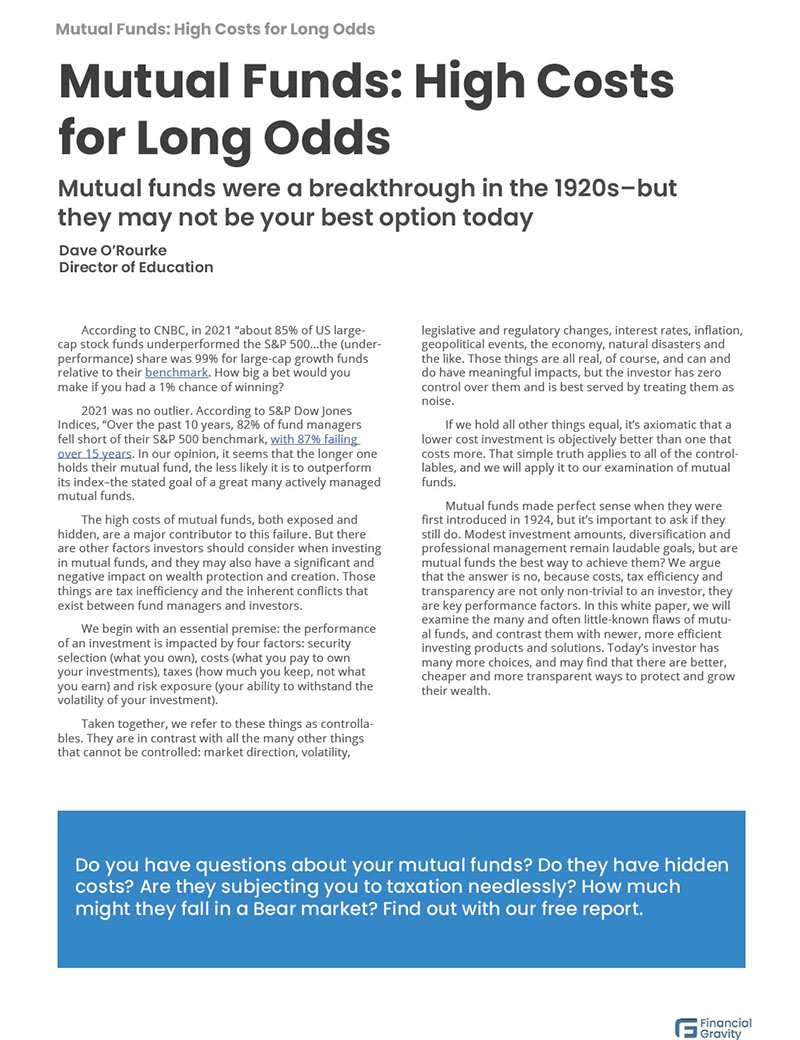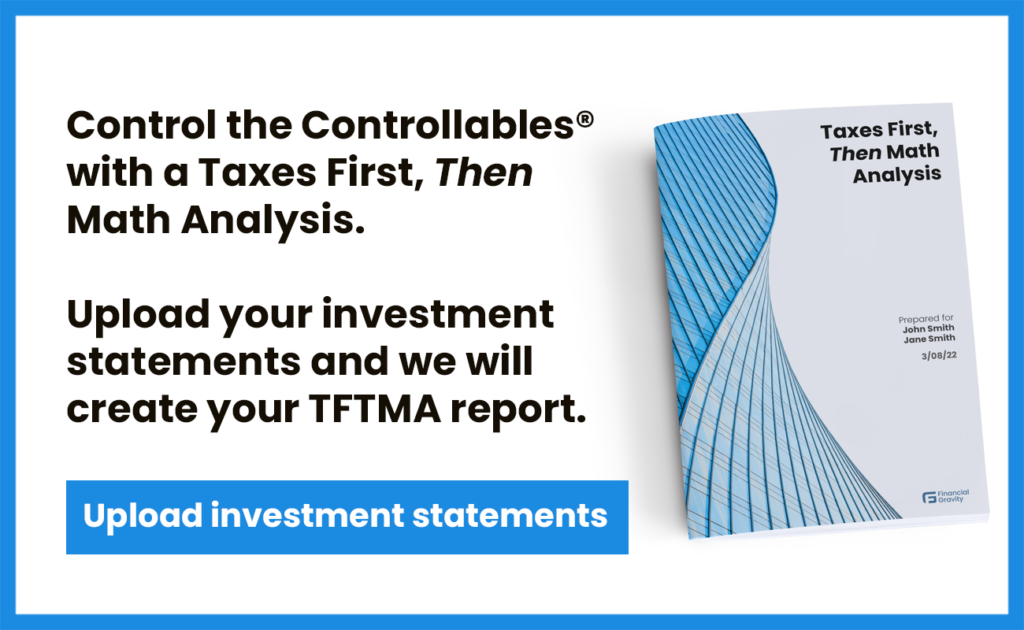Professionals in the wealth management business live in a noisy world. Their clients, the American people, are bombarded daily with news about the markets and the economy—you can’t blame them for being worried about their financial fortunes.
The advisors they turn to for guidance need to avoid predictions and prognostications and focus on four “controllables” that can be affected by disciplined decision-making. Those four things are the costs their clients have to pay for financial advice and services, the taxes the clients must pay on income, gains, and estates, the diversification of risks, and the overall alignment of portfolio volatility with the needs and tolerance of the client.
New tax legislation, like the weather and inflation, is something we can only react to, not control. It’s not only nearly impossible to predict what Congress will do, it’s pure speculation to predict what the impact of new legislation will be. However, investors should be concerned that the epic and rapidly growing mountain of government debt may become their personal problem at some point.
Every American taxpayer is already on the hook for over a quarter of a million dollars, and that’s before consideration of the upside-down finances of federal entitlement programs, or the potentially staggering costs to achieve Net Zero. It seems inevitable that some people will be disappointed over the changes that will have to be made, but whatever your policy preferences are, solutions to these problems are undeniably going to be hugely expensive.
Somebody Is Going to Be Very Disappointed
A website called usdebtclock.org provides some sobering information. Here are a few data points as of May 18th: U.S. National debt is $34.75 trillion, which works out to $266,952 per taxpayer. When we add in the unfunded debt from entitlements, U.S. debt is over $100 trillion, while the average family savings is $7,685. This year’s deficit (the U.S. fiscal year begins October 1st) is already over $1.8 trillion.
From 2020 to 2024, the federal government added $11 trillion to the national debt, according to the Federal Budget in Pictures website. The first $11 trillion took from George Washington to Barack Obama to accumulate, a 220 year period.
Things are only getting more serious. CNBC estimates that the debt will grow by another trillion dollars every 100 days. Higher interest rates only make things worse: CBS has reported that the interest on our national debt will hit $870 billion in FY2024, higher than the $822 billion we’ll spend on defense this year.
Per the nonpartisan Congressional Budget Office, the federal deficit in 2023 was $1.7 trillion, equal to 6.3 percent of gross domestic product. The CBO’s budget and economic outlook projects federal budget deficits totaling $20 trillion over the 2025–2034 period, and federal debt held by the public will reach 116 percent of GDP.
Taxes, Then and Now
The U.S. Constitution has been in operation since 1789. Article I, Section 8, Clause 2 of the Constitution is known as the “spending and borrowing power.” It grants Congress broad power to borrow and spend money as it sees fit for the “general welfare” of the country.
The Sixteenth Amendment to the Constitution was ratified in 1913. “The Congress shall have power to lay and collect taxes on incomes, from whatever source derived, without apportionment among the several States, and without regard to any census or enumeration.”
U.S. Supreme Court Justice Oliver Wendell Holmes famously said, “Taxes are the price we pay for a civilized society” in 1927. Over the course of the past 111 years, that price, measured by income taxes, has varied widely: In 1913, when income taxes were introduced, fewer than 1% of Americans actually owed taxes as the brackets were set high. Even given that, most only paid 1% of their income, and the top bracket, which was on amounts above $500,000, was 7% (equivalent to $11 million in 2024 dollars). That would change rapidly, as Congress got used to the power to tax incomes.
In 1916, the top rate jumped to 15% on amounts over $2 million. The very next year, 1917, the top rate jumped to 67%. The year after that it moved up to 77%, and that was amounts over only $1 million. In 1922, the top rate dropped to 58% but the top bracket dropped to $200,000.
Tax reform in the mid 1920s dropped the top marginal rate to 25%, but in ‘32 it exploded again up to 63%. In ‘36 it hit 79%, in ‘44 rose to 88%, and in 1944 topped out at 94%. It stayed in the 90 percent range until 1964. From then until the Reagan tax reform in ‘82 it was in the 70’s, after which it moved down to 38.5% in `87. It’s been in the upper 30s ever since.
The U.S. has never known the kind of debt it has today, and it seems prudent to consider that either drastic spending cuts or significantly higher taxes, or some combination of both, simply must be enacted. The Biden administration’s proposed budget for 2025 calls for $7 trillion in new taxes, across a wide swathe of policy.
The “middle class tax relief” passed in the Trump administration sunsets in the bill as proposed. It’s estimated that the sunsetting will raise $2 trillion. There are other proposals that readers should know about.
Here’s a big one: removal of the so-called “step-up loophole” on amounts above $5 million for single filers and $10 million for joint filers. The step-up refers to inherited property; the heir’s cost basis on their new assets is its value on the date of death of the decedent. According to the House Ways and Means website, this could force family farms and ranches and other businesses to sell off assets to pay the estimated $100 billion in death taxes this change would bring.
Per the White House, the minimum tax rate on billion-dollar corporations will rise from 15% to 21%. U.S. multinational corporations would see tax on foreign earnings rise from 10.5% to 21%. Their proposal would also deny deductions for all compensation over $1 million paid to any employee of a C corporation. The stock buyback tax would quadruple, from 1% to 4%.
Some readers will want to pay special attention to this one: quoting White House Fact Sheet published on March 11, “The Budget closes the ‘like-kind exchange’ loophole, a special tax subsidy for real estate. This loophole lets real estate investors—but not investors in any other asset – put off paying tax on profits from deals indefinitely as long as they keep investing in real estate.”
In a big change to capital gains treatment, the Fact Sheet also says that households making over $1 million will pay a 39.6% marginal rate on capital gains and dividends. Capital gains currently top out at 20%. Note that the budget proposes raising the current top marginal rate of 37%.
Hope for the Best, Plan for the Worst
Worst-case scenario planning can prevent a lot of problems, and the good news is that if the worst case doesn’t happen, you’re still in good shape. Whatever your opinion about the price of civilization, you would be wise to stress test your retirement plan against new, higher taxes across a host of potential outcomes.
Elimination of the 1031 real estate exchange rule could have a massive impact on financial and estate plans, as could the loss of the step-up rule. Higher marginal rates and capital gains treatment could affect the spending plans of many families. The time to consider what these proposals could mean for your financial security is now.
Anything may happen in the negotiations over Biden’s budget proposals, and much will depend upon the November elections. As stated up front, these things are beyond our control. What we can control is gaming the impacts on financial plans and retirement security under different scenarios, and we suggest it would be wise to do so.
As we’ve remarked in previous editions of the Family Office Chronicle, we’re reminded of Hemingway’s formerly wealthy character in The Sun Also Rises. When asked how he went bankrupt, he replied, “Two ways: gradually, then suddenly.” America’s debt problems have been gradually getting worse for decades. It begs the question: when you are $34 trillion in nominal debt, and $100 trillion, including unfunded promises, can suddenly be far off?



